Demantoid garnet is a rare and highly valued variety of garnet known for its striking green color and exceptional brilliance. It is considered one of the most valuable members of the garnet family due to its unique characteristics and scarcity in nature. In addition to its vibrant hue, demantoid garnet is often prized for its remarkable dispersion, which gives it a fiery sparkle reminiscent of diamond.
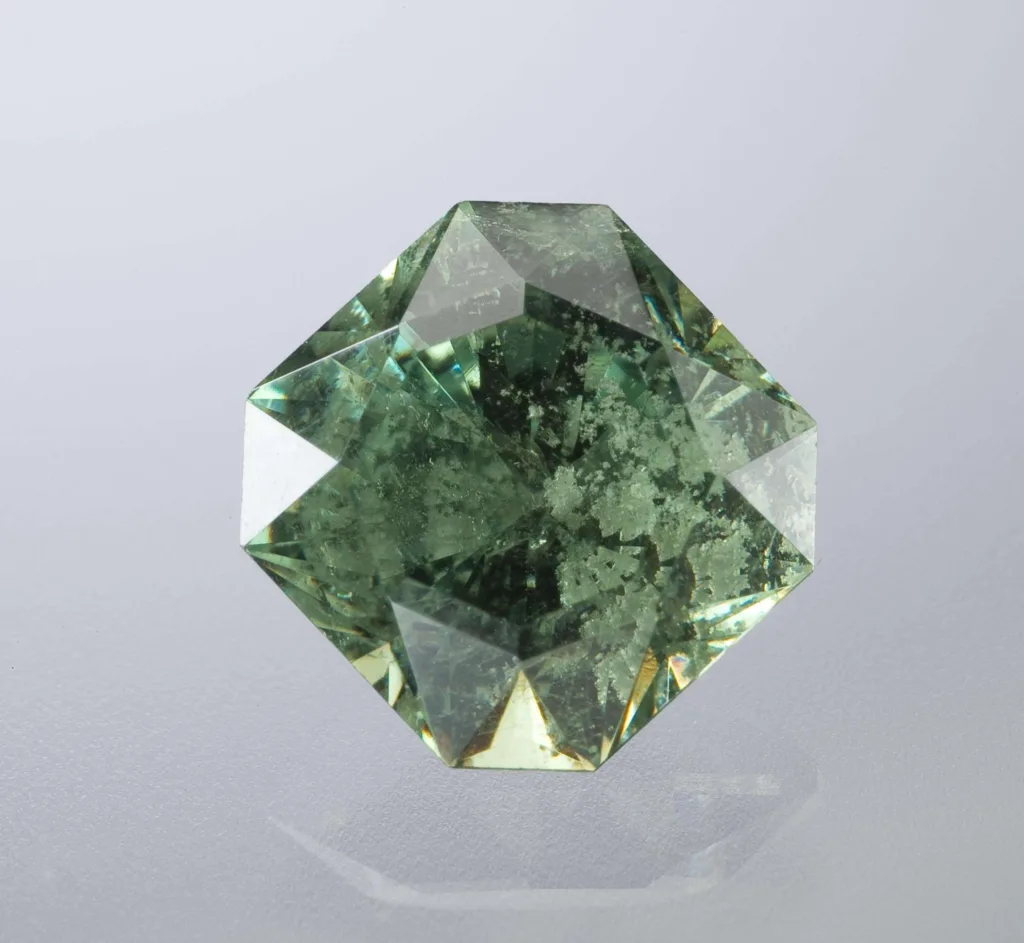
Definition of Demantoid Garnet:
Demantoid garnet belongs to the garnet group of minerals, which encompasses a diverse range of gemstones with varying colors and properties. What sets demantoid garnet apart is its distinctive green coloration, which can range from a vivid emerald green to a more yellowish or brownish green hue. The name “demantoid” is derived from the Dutch word “demant,” meaning diamond, owing to its diamond-like brilliance.
Brief History and Origin:
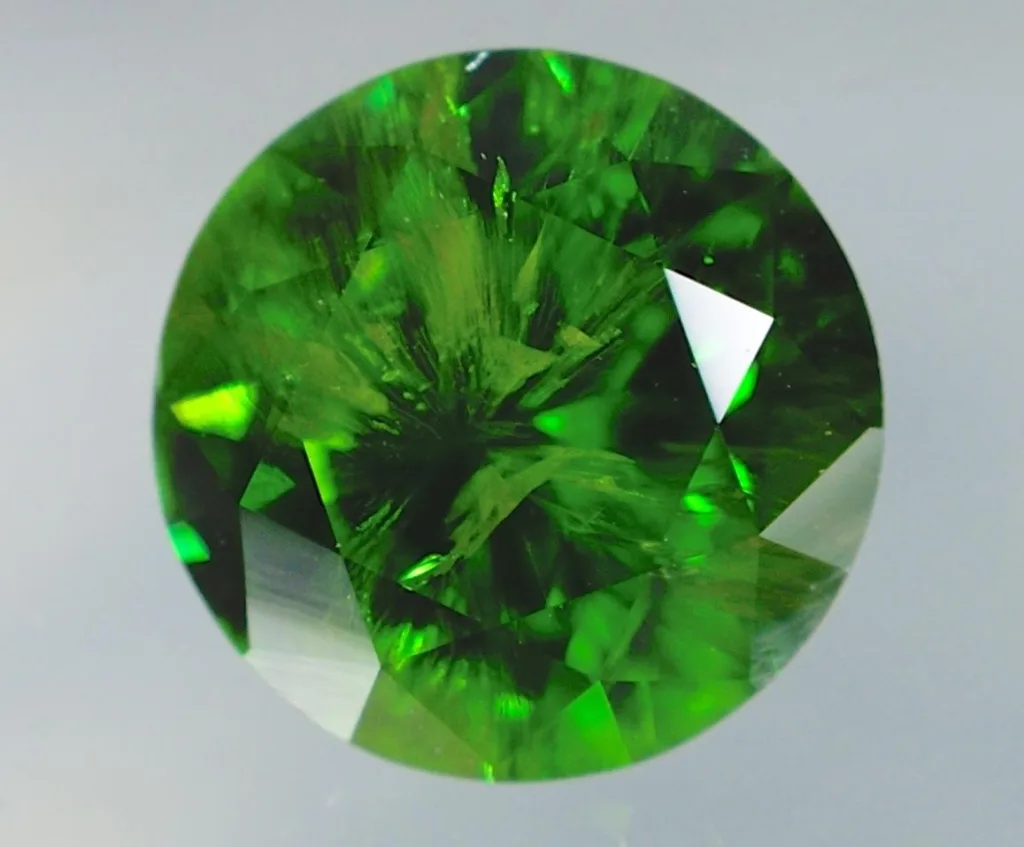
Demantoid garnet was first discovered in the Ural Mountains of Russia in the mid-19th century, specifically in the 1860s. The Russian demantoid garnets quickly gained popularity among European royalty and aristocracy due to their exceptional beauty and scarcity. They were often used in high-end jewelry pieces during the Art Nouveau period, contributing to the gemstone’s allure and prestige.
While Russia was the primary source of demantoid garnets for many years, deposits have since been found in other parts of the world, including Namibia, Italy, Madagascar, and Iran. However, Russian demantoids remain the most coveted and valuable due to their fine quality and historical significance.
The formation of demantoid garnet is typically associated with metamorphic rocks, where it forms in association with serpentine and other minerals. Its green color is attributed to the presence of trace amounts of chromium or iron within the crystal structure.
Today, demantoid garnet continues to be highly sought after by collectors and connoisseurs of fine gemstones, prized for its rarity, beauty, and exceptional optical properties.
Geological Formation
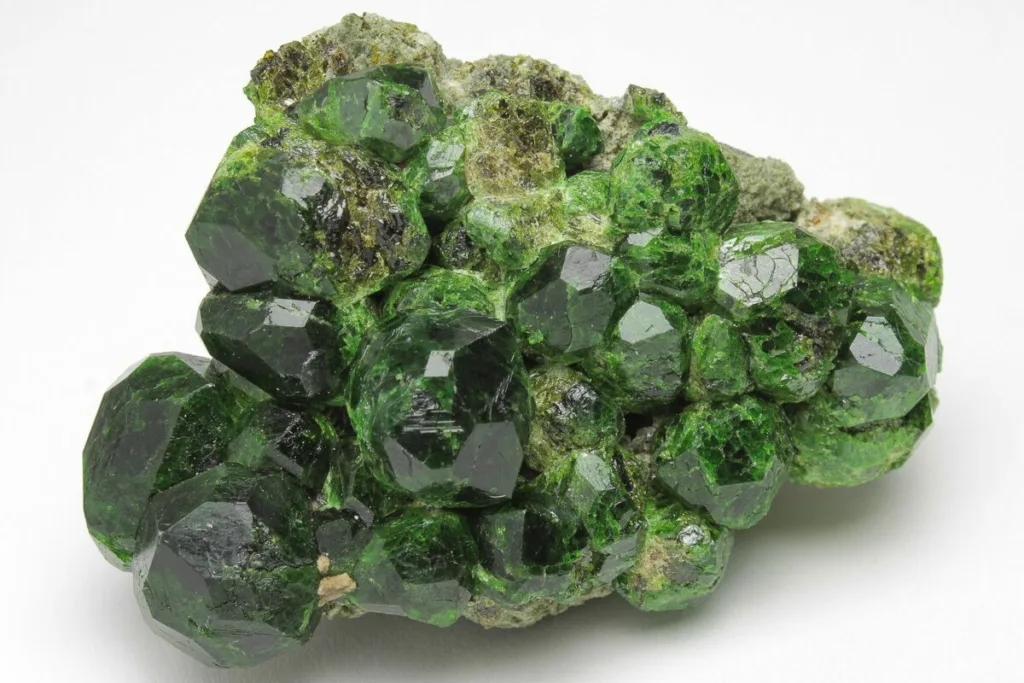
Demantoid garnet, like other varieties of garnet, forms under specific geological conditions, primarily within metamorphic rocks. Here’s an overview of the geological formation of demantoid garnet:
- Metamorphism: Demantoid garnet typically forms through the process of regional metamorphism. Metamorphism occurs when pre-existing rocks are subjected to high temperature and pressure conditions within the Earth’s crust. These conditions cause the minerals within the rock to recrystallize and reorganize, leading to the formation of new minerals, including garnet.
- Parent Rocks: The parent rocks from which demantoid garnet originates can vary but are often associated with serpentinite or other ultramafic rocks. Serpentinite is a metamorphic rock derived from the alteration of ultramafic rocks such as peridotite or dunite. These rocks are rich in magnesium and iron, which are essential components for the formation of garnet.
- Hydrothermal Activity: In some cases, demantoid garnet formation may also involve hydrothermal activity. Hydrothermal fluids rich in silica, aluminum, and other elements can infiltrate the metamorphic rocks, providing the necessary ingredients for garnet growth.
- Chemical Composition: Demantoid garnet belongs to the garnet group of minerals, which have a general chemical formula of X3Y2(SiO4)3, where X and Y represent various metallic elements such as calcium, magnesium, iron, aluminum, and chromium. The green color of demantoid garnet is typically attributed to the presence of chromium and/or iron within its crystal structure.
- Crystallization: As metamorphism progresses, conditions become favorable for the crystallization of garnet within the rock. Demantoid garnet forms as individual crystals or aggregates within the host rock. The growth of garnet crystals occurs over an extended period, with the crystals gradually developing their distinctive green color and internal features.
- Secondary Processes: After their formation, demantoid garnet crystals may undergo secondary processes such as weathering and erosion. They can be released from their host rocks and transported by natural processes such as rivers and streams. Eventually, they may be deposited in sedimentary environments or concentrated in alluvial deposits, where they can be mined.
Overall, the geological formation of demantoid garnet involves a complex interplay of metamorphic processes, chemical reactions, and geological conditions over millions of years. This results in the creation of one of the most sought-after and visually stunning gemstones in the world.
Physical Characteristics

Demantoid garnet exhibits several distinct physical characteristics that contribute to its unique appearance and desirability as a gemstone:
- Color: Demantoid garnet is renowned for its vibrant green color, which can range from a vivid emerald green to a more yellowish or brownish green hue. The intensity and saturation of the green coloration can vary depending on factors such as the presence of trace elements and the quality of the crystal.
- Dispersion: One of the most remarkable features of demantoid garnet is its high dispersion, which refers to its ability to split light into its spectral colors. This dispersion gives demantoid garnet a fiery sparkle and brilliance reminiscent of diamond, earning it the nickname “the emerald of the Urals.”
- Luster: Demantoid garnet typically exhibits a vitreous to adamantine luster, giving it a bright and reflective appearance when polished. The combination of its high luster and dispersion contributes to its exceptional brilliance and scintillation.
- Clarity: Demantoid garnet crystals are often transparent to translucent, allowing light to pass through them and enhance their color and brilliance. Inclusions are common in natural demantoid garnets, but they can vary in type and visibility. Some inclusions, such as horsetail inclusions of asbestos, are highly prized by collectors and can increase the gemstone’s value.
- Cut: Demantoid garnet is commonly faceted to enhance its brilliance and maximize its optical properties. The most popular cuts for demantoid garnet include brilliant cuts such as round, oval, and cushion cuts, as well as fancy cuts such as pear and marquise shapes. Cabochon cuts are also used for opaque or translucent demantoid garnets.
- Hardness: Demantoid garnet has a hardness of 6.5 to 7.5 on the Mohs scale, making it relatively durable and suitable for use in jewelry. However, it may still be susceptible to scratches and abrasions, particularly from harder materials such as diamond or corundum.
- Crystal Structure: Demantoid garnet crystallizes in the cubic system, forming dodecahedral or trapezohedral crystals. Its crystal structure contributes to its optical properties, including its dispersion and pleochroism (the ability to exhibit different colors when viewed from different angles).
Overall, the physical characteristics of demantoid garnet make it a highly prized and collectible gemstone, valued for its beauty, rarity, and exceptional optical properties.
Chemical Composition
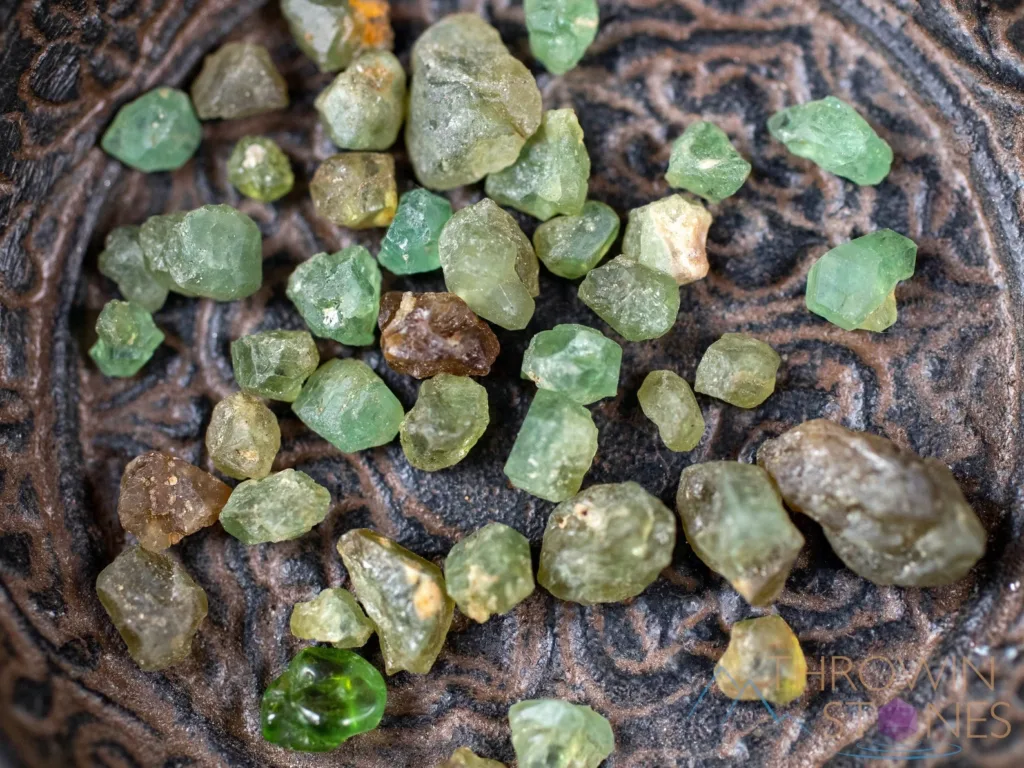
Demantoid garnet belongs to the garnet group of minerals, which encompass a diverse range of gemstones with similar crystal structures but varying chemical compositions. The chemical composition of demantoid garnet can be generalized using the chemical formula for garnet, which is X3Y2(SiO4)3, where:
- X represents a divalent cation such as calcium (Ca), magnesium (Mg), ferrous iron (Fe^2+), or manganese (Mn).
- Y represents a trivalent cation such as aluminum (Al), ferric iron (Fe^3+), chromium (Cr), or vanadium (V).
The specific chemical composition of demantoid garnet can vary depending on the presence and proportions of these elements within its crystal structure. However, chromium (Cr) is typically the element responsible for the green coloration of demantoid garnet, while other elements may contribute to its overall appearance and properties.
In demantoid garnet, the chromium content is often the primary factor influencing its color, with higher chromium concentrations resulting in more intense green hues. Additionally, trace elements such as iron (Fe) and calcium (Ca) may also be present in demantoid garnet, influencing its color and other physical characteristics.
Overall, demantoid garnet’s chemical composition contributes to its distinctive green color, exceptional brilliance, and other optical properties, making it one of the most sought-after and valuable varieties of garnet.
Historical Significance and Cultural Importance
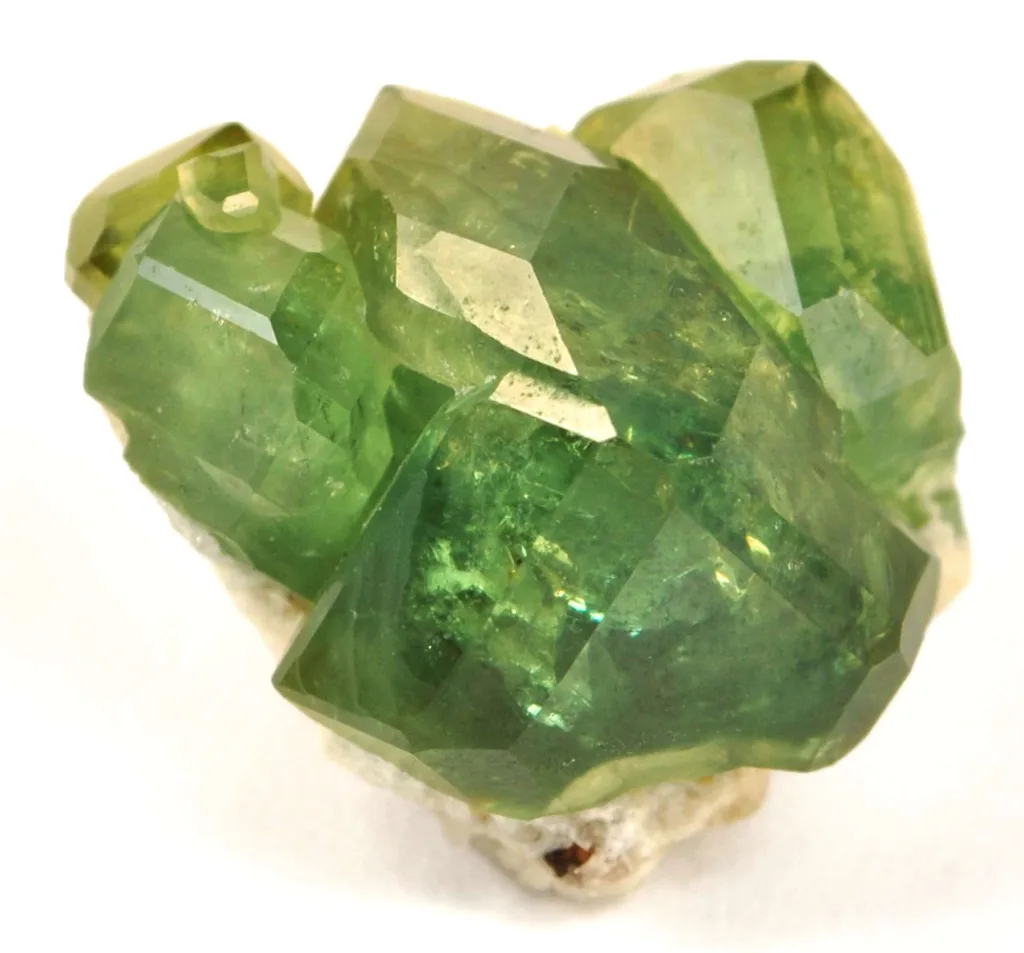
Demantoid garnet holds historical significance and cultural importance primarily due to its rarity, beauty, and association with the Russian Empire. Here are some key points highlighting its historical and cultural significance:
- Russian Origin: Demantoid garnet was first discovered in the Ural Mountains of Russia in the mid-19th century. The Russian demantoids quickly gained attention for their exceptional brilliance, vivid green color, and high dispersion, earning them admiration from European royalty and aristocracy.
- Imperial Favor: Russian demantoid garnets became highly sought after by the Russian Imperial Court and were often used in jewelry commissioned by the Russian Tsars and nobility. These gemstones adorned exquisite pieces of jewelry, including tiaras, necklaces, and brooches, showcasing the gemstone’s beauty and desirability.
- Art Nouveau Era: During the Art Nouveau period in the late 19th and early 20th centuries, demantoid garnet gained further popularity among artists, designers, and collectors. The gemstone’s vibrant green color and fiery brilliance perfectly complemented the organic forms and intricate designs characteristic of Art Nouveau jewelry and decorative arts.
- Symbolism and Prestige: Demantoid garnet came to symbolize wealth, luxury, and prestige, particularly in European high society. Its association with the Russian Empire and its use in royal jewelry added to its allure and cultural significance, making it a highly prized gemstone among the elite.
- Revival in Modern Times: While the Russian deposits of demantoid garnet have been largely depleted, the gemstone continues to be highly valued and sought after by collectors, designers, and connoisseurs of fine gemstones. New deposits of demantoid garnet have been discovered in other parts of the world, such as Namibia and Madagascar, contributing to its continued availability in the market.
- Collector’s Gemstone: Today, demantoid garnet remains a favorite among gemstone collectors and enthusiasts due to its rarity, exceptional optical properties, and historical significance. Fine-quality demantoid garnets with intense green color, high clarity, and attractive inclusions, such as horsetail inclusions, command premium prices in the gemstone market.
In summary, demantoid garnet’s historical significance and cultural importance stem from its association with the Russian Empire, its use in royal jewelry, its popularity during the Art Nouveau era, and its enduring allure as a symbol of luxury and prestige.
Applications and Uses
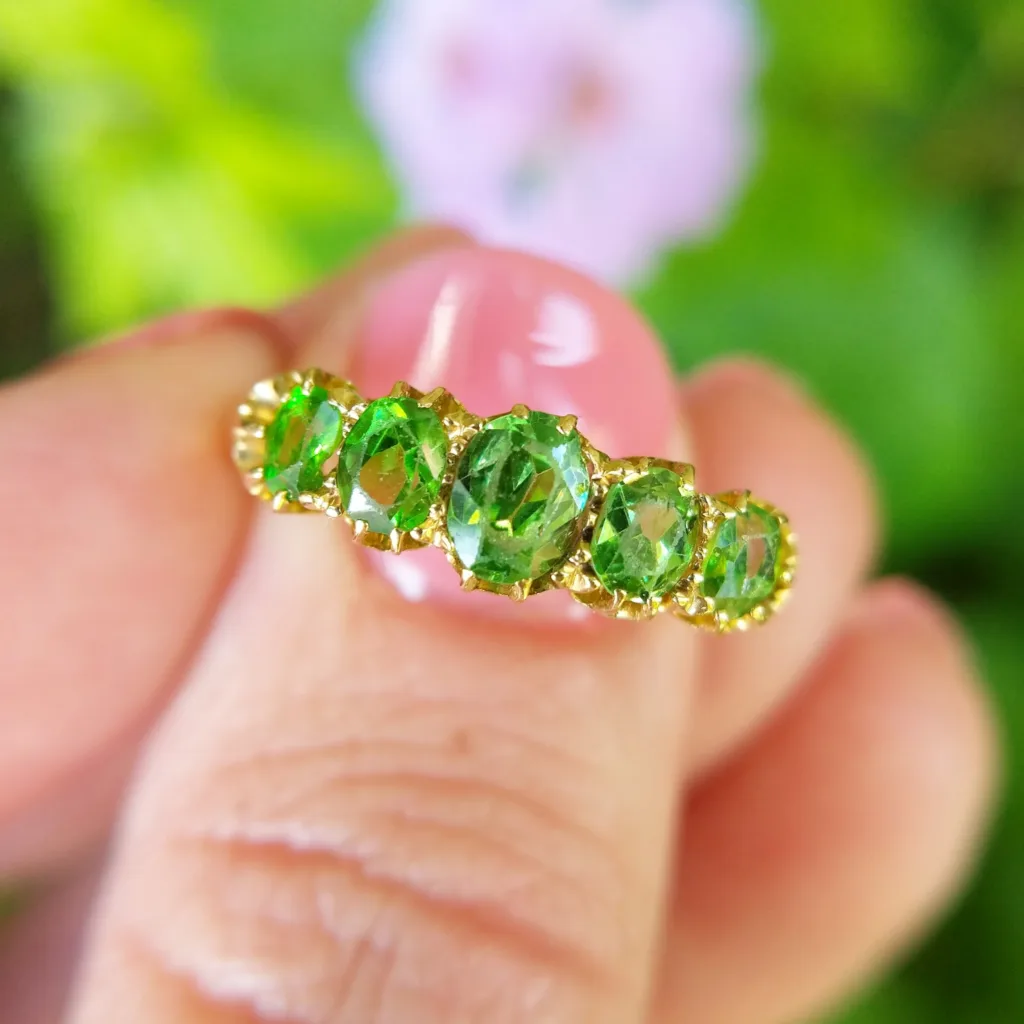
Demantoid garnet, prized for its beauty and rarity, finds various applications and uses primarily in the realm of jewelry and decorative arts. Here are some of the key applications and uses of demantoid garnet:
- Fine Jewelry: Demantoid garnet is highly valued as a gemstone for fine jewelry due to its vibrant green color, exceptional brilliance, and rarity. It is often featured as the focal point in rings, earrings, necklaces, pendants, and bracelets. The gemstone’s high dispersion and luster make it especially appealing for use in statement pieces and high-end jewelry designs.
- Antique and Vintage Jewelry: Demantoid garnet has a rich historical significance and is frequently found in antique and vintage jewelry pieces, particularly those from the late 19th and early 20th centuries. It was favored by jewelry designers during the Art Nouveau period and can be found in heirloom jewelry collections and museum exhibits.
- Collector’s Gemstones: Demantoid garnets with exceptional color, clarity, and unique inclusions, such as horsetail inclusions, are highly prized by gemstone collectors and enthusiasts. Collectors often seek out rare and fine-quality demantoid garnets to add to their collections, appreciating the gemstone for its rarity, beauty, and historical significance.
- Designer Jewelry: Many contemporary jewelry designers incorporate demantoid garnet into their designs to create distinctive and luxurious pieces. The gemstone’s vivid green color and fiery brilliance make it a popular choice for designers seeking to create unique and eye-catching jewelry collections for discerning clients.
- Birthstone Jewelry: While not a traditional birthstone, demantoid garnet is sometimes used as an alternative birthstone for the month of January. Its green color symbolizes vitality, growth, and prosperity, making it a meaningful and attractive option for individuals born in January or those who appreciate its symbolism.
- Investment: Fine-quality demantoid garnets with exceptional color, clarity, and provenance can be considered investment-grade gemstones. As with other rare and highly desirable gemstones, demantoid garnets with desirable characteristics can appreciate in value over time, making them a potential investment opportunity for collectors and investors.
Overall, demantoid garnet’s applications and uses revolve around its beauty, rarity, and historical significance, making it a coveted gemstone in the world of jewelry, decorative arts, and gemstone collecting.
Locations of Deposits
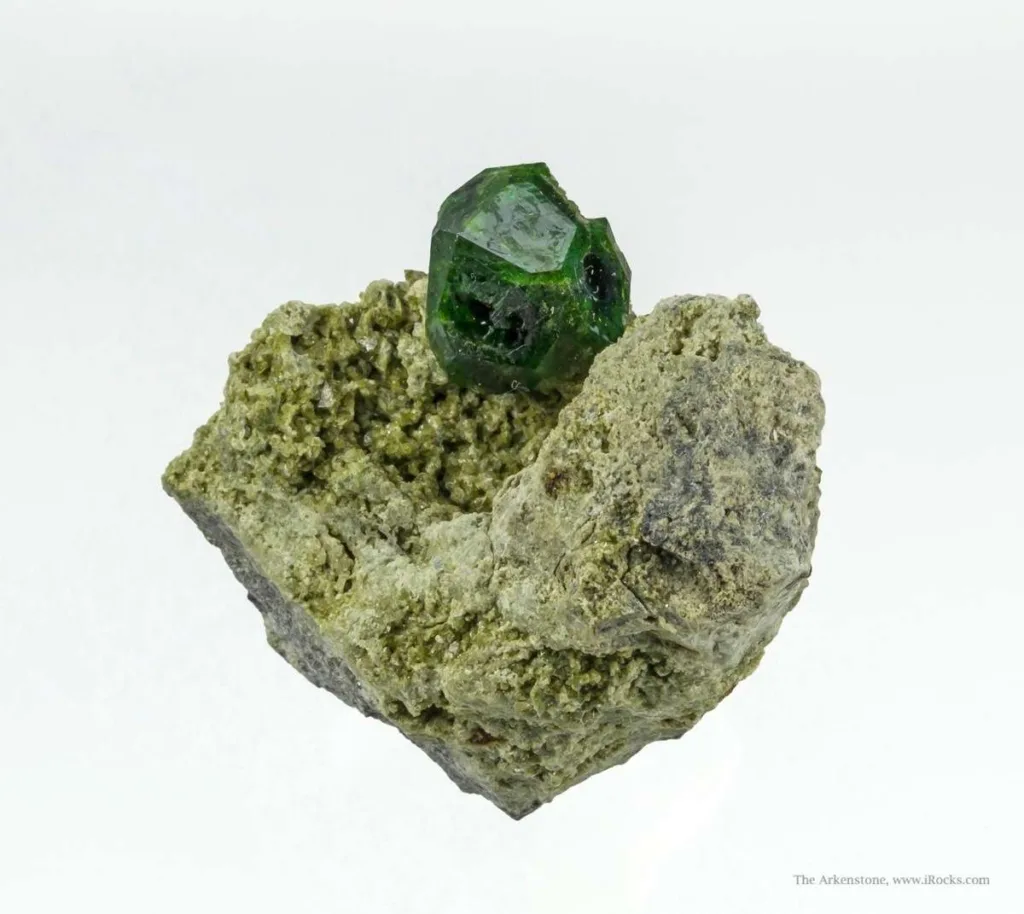
Demantoid garnet deposits have been found in various locations around the world, although some of the most renowned sources are associated with specific historical significance and high-quality gemstones. Here are some notable locations where demantoid garnet deposits have been discovered:
- Russia (Ural Mountains): The Ural Mountains in Russia are the original and most famous source of demantoid garnets. The Russian demantoids, particularly those from the late 19th century, are highly prized for their exceptional color, clarity, and dispersion. The deposits in the Ural Mountains were extensively mined during the 19th and early 20th centuries, but production has significantly declined since then.
- Namibia (Erongo Region): Namibia has emerged as a significant source of demantoid garnets, particularly in the Erongo Region. The Namibian demantoids are known for their vibrant green color and high clarity. The deposits in Namibia have been actively mined since the late 20th century, contributing to the availability of demantoid garnets in the global market.
- Italy (Val Malenco): The Val Malenco region in Lombardy, Italy, is another notable source of demantoid garnets. Italian demantoids are highly regarded for their intense green color and exceptional clarity. The deposits in Val Malenco have been known since the 19th century, and mining activities continue to yield gem-quality demantoid garnets.
- Madagascar: Madagascar is a significant source of demantoid garnets, with deposits found in various regions across the country. The Madagascar demantoids are valued for their attractive green color and good clarity. The gemstone deposits in Madagascar have been commercially exploited since the late 20th century, contributing to the availability of demantoid garnets in the market.
- Iran: Iran is known to have demantoid garnet deposits, although they are less well-known compared to other sources. Iranian demantoids are appreciated for their green coloration and unique characteristics. The deposits in Iran have been mined sporadically, and production levels vary.
- Other Locations: Demantoid garnet deposits have also been reported in other countries, including Pakistan, Afghanistan, and the United States. However, these sources are generally less significant in terms of production compared to the aforementioned locations.
Overall, demantoid garnet deposits are scattered across different parts of the world, with each source contributing to the availability and diversity of this rare and highly valued gemstone.




































